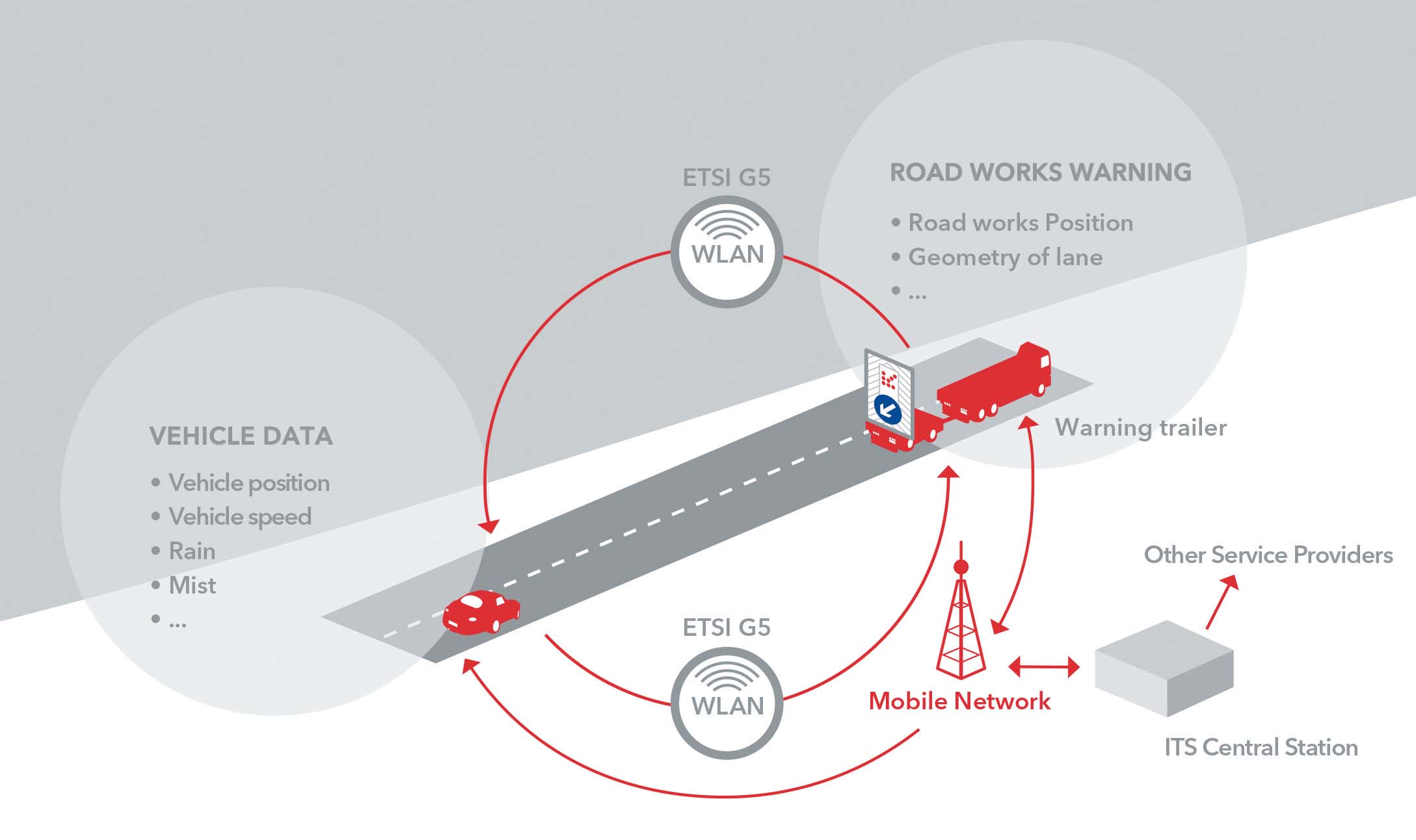Austria's national road operator, ASFINAG, has launched the TMCplus traveller information service which is unusual in that it offers encrypted-level services to all users free of charge. Martin Müllner writes

Figure 2 : TMCplus conformity test enviroment
Austria's national road operator, ASFINAG, has launched the TMCplus traveller information service which is unusual in that it offers encrypted-level services to all users free of charge. Martin Müllner writes
In October 2002 the first area-wide RDS-TMC service operated by the Austrian public broadcasterASFINAG operates about 2,200km (1,360 miles) of motorways in Austria. On most, an area-wide traffic data collection system is implemented. ASFINAG is currently operating 10 line control and traffic management systems in high-density areas. The company's digital multicast video system provides live streams from more than 2,000 cameras on the high-level road network. As a result of the co-operation between ASFINAG and ORF this content is available for traffic information services and is the basis for the new TMCplus service in Austria.
What is TMCplus?
TMCplus can be seen as a huge upgrade of the existing TMC service, adding new features and functions to set a new standard for on-trip traveller information services. Improvements have also been made in order to provide better traffic information.Official area-wide commencement of the TMCplus service took place on 1 July 2009. The goal of TMCplus is to provide the road user with more precise, more topical traffic information. Furthermore the reliability of the traffic messages should be increased and the clearing of messages should be optimised.
ORF has since 2002 operated the only TMC service in Austria. In addition, one of the goals of TMCplus is to reach as many as road users as possible. TMCplus is not encrypted, therefore. TMCplus is the only TMC service in Austria and ASFINAG and ORF are defining a new way of providing professional TMC services within Europe. Most professional services in Europe are encrypted, meaning that the information can only be received if users pay for the service. The Austrian TMCplus service has matched the quality levels of other professional TMC services in Europe. The difference is that road users with existing TMC receivers are also able to receive the service. TMCplus covers the motorway and federal road network as well as the areas around the nine regional capital cities and the seven most traffic-relevant cities in Austria.
Technical improvements
TMCplus fully works on the RDS-TMC specification as specified in the relevant CEN specifications. It includes quite a number of technical improvements over the preceding TMC service offered in Austria. In practice that means that the quality of service implementation has been improved. In addition, the quality of the TMC receivers is checked as a result of the introduction of a conformity testing regime.The 'traditional' TMC service in Austria could be regarded as providing a medium service level. What that means is that it normally takes about 10 minutes to receive the total message queue (with 50-100 on air messages at any one time; emergency messages are transmitted with a higher priority).
With the introduction of TMCplus the following technical improvements have been achieved: an increase of the TMC rate within the RDS data stream; regionalisation of the TMCplus service; and improvement of the TMC transmitters as well as the controlling hard- and software.
An aim was that regional message queues could be received within two to four minutes, a time decrease of 60-75 per cent over what happened before. Tests under full operation have shown that the time for transmission of the total message queue is in fact less than one minute.
Optimising the service
By comparison with pre-existing RDS-TMC services in Austria, a series of improvements have been realised with the implementation of TMCplus.In terms of optimisation of the broadcasting network there has been an increase of: TMCplus bandwidth from 11 up to 22 per cent within the RDS band; transmission rate of TMCplus messages; and system availability.
The transmission protocol has been adjusted on the output module from UDP to RDS. The RDS-TMC service is creating directly four data streams. As a result of a new network interface on the coders, the data streams can be sent directly over the ORF network to the programme coders of the Ö1, Ö2, Ö3 and FM4 radio stations. With the new protocol the messages need only to be sent once to the coders instead of three times as in the current RDS-TMC service, which means that the data transmission rate is three times higher.
In the past all traffic messages for Austria have been transmitted area wide on all TMC transmitters. With the implementation of TMCplus the traffic messages are sorted by region (East, Middle and West) and transmitted locally (Figure 1). In the overlapping areas the messages are transmitted for both regions. The result is that more messages can be transmitted per region.
With regionalisation the bit rate has increased in the West and East regions by 50 per cent and by 33 per cent in the Middle region.
As a result of the co-operation between ASFINAG and
ASFINAG and Ö3 are using anonymous data from the Austrian Electronic Fee Collection (EFC) system. From these data the average travel times and level of service for each EFC section are calculated. Warning messages from ASFINAG's road weather information system with current weather information and forecasts for the next 72 hours are used for TMCplus. The editors from the Ö3 traffic department can also use more than 2,000 live video cameras from ASFINAG's motorways.
Improvement of the clearance of traffic messages is a significant step forward. Using more automatically generated data means that congestion-related messages can be annulled immediately. The application of traffic sensors on the motorway network also improves location of where a traffic event happens. The result is a more precise service.
The TMCplus service will be extended with Interroad messages for the neighbouring countries (Germany, Italy and Switzerland) and the necessary data exchanges between Austria and its neighbours are already in operation.
User support and conformity testing
Several market analyses have shown that most road users do not know of RDS-TMC or its features. Therefore user support is an important topic within the implementation of the TMCplus service, and ASFINAG and ORF are providing an information hotline for TMCplus users.In order to provide an optimised service quality to the TMCplus customers, ASFINAG and Ö3 offer TMCplus conformity testing to the receiver manufacturers as well as the car industry. The main focus of the testing is correct implementation of the Austrian Location and Event Table as well as the decoding of TMCplus messages (Figure 2). Tested devices receive a certificate from ASFINAG and Hitradio Ö3. The tested manufacturer of the device is authorised to use the TMCplus certification as a sales aid, for example on the packaging of a device or in advertisements. The certification is branded with ASFINAG and Ö3 trademarks and end users get information concerning the conformity testing. The conformity testing is optional for the receiver industry and the costs for the testing need to be covered by the manufacturer. Testing itself is done in ASFINAG's lab in Klagenfurt and commenced in the second quarter of 2009.
To date, conformity testing of navigation devices has been a full success. By the end of October 2010, 43 navigation devices from seven navigation device manufacturers and two car manufacturers had been tested. The TMCplus conformity label (Figure 3) is well used on the products in the Austrian market and is also established among end users as a quality label.
Costs and revenues of TMCplus
The TMCplus service is free of charge to end users. To cover, to some extent, the expense of the implementation of the service ASFINAG, as the owner of the Austrian RDS-TMC Location Table, uses a license model. It asks all software and receiver manufacturers that offer TMCplus products within the Austrian market to pay a yearly license fee.Summary
The TMCplus service is a new approach for future professional TMC services. It is focused on the users in order to provide them with high-quality traffic information on their navigation devices by using TMC without additional fees. TMCplus is fully compatible with existing TMC service and CEN standardisation but with an improvement in the quality of the service implementation..Launching TMCplus was an important step to achieve the vision of ASFINAG to be one of the leading motorway operators in Europe, especially when it comes to availability, information and safety, establishing main links and interconnectedness to the public transport system.











